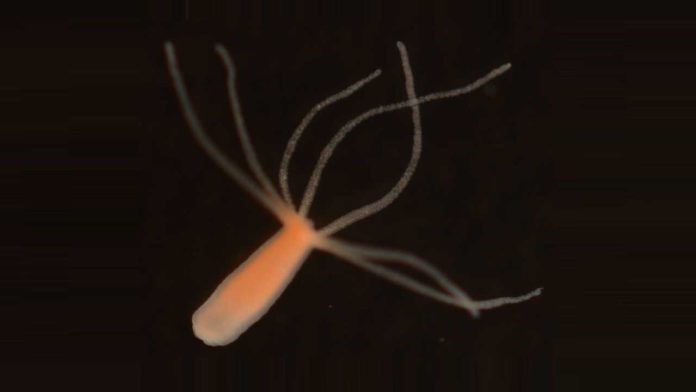Sleep behaviors are observed in animals, yet little is known about how sleep-regulatory mechanisms have emerged during evolution.
A new study sheds light on the evolutional origin of sleep in animals. Scientists from the Kyushu University in Japan and Ulsan National Institute of Science and Technology in Korea performed a study on the Cnidaria.
In this sense, Cnidaria is ideally positioned in the phylogenetic tree of the animal kingdom. Cnidarians lack a centralized nervous system and thus are thought not to have a brain. Their diffuse nerve net innervates most parts of the body, likely representing the nervous system’s ancestral organization.
In this study, scientists found that tiny, water-dwelling hydras not only show signs of a sleep-like state despite lacking central nervous systems but also respond to molecules associated with sleep in more evolved animals.
The study offers significant evidence that animals must have acquired the need to sleep before acquiring a brain.
Like humans, several chemicals that elicite drowsiness and sleep have a similar impact on cnidarian Hydra Vulgaris. Based on the findings, scientists believe that sleep evolution is independent of brain evolution.
Taichi Q. Itoh, assistant professor at Kyushu University’s Faculty of Arts and Science, said, “Many questions remain regarding how sleep emerged in animals, but hydras provide an easy-to-handle creature for further investigating the detailed mechanisms producing sleep in brainless animals to help possibly one day answer these questions.”
While sleep is often monitored based on brain waves, this is not an option for tiny, brainless animals. As a solution, scientists used a video system to track movement to determine when hydras were in a sleep-like state characterized by reduced movement—which could be disrupted with a flash of light.
Instead of repeating every 24 hours like a circadian rhythm, the scientists found that the hydras exhibit a four-hour cycle of active and sleep-like states.
Significantly, scientists revealed many similarities related to sleep regulation on a molecular and genetic level regardless of the possession of a brain.
Presenting the hydras to melatonin, a commonly used sleep aid, respectably expanded the sleep amount and frequency. The inhibitory neurotransmitter GABA, another chemical linked to many animals’ sleep activity, incredibly increased sleep activity.
Then again, dopamine, which causes arousal in many animals, really prompted sleep in the hydras.
Itoh said, “While some sleep mechanisms appear to have been conserved, others may have switched function during the evolution of the brain.”
Later on, when scientists use vibrations and temperature changes to disturb the hydras’ sleep and induce signs of sleep deprivation, hydras tend to sleep longer during the following day and even suppressing cell proliferation.
Sleep deprivation prompted changes in the expression of 212 qualities, including one identified with PRKG, a protein associated with sleep regulation in many animals, including mice, fruit flies, and nematodes.
Disrupting other fruit fly genes appearing to share a common evolutional origin with the sleep-related ones in hydras altered sleep duration in fruit flies, and further investigation of such genes may help to identify currently unknown sleep-related genes in animals with brains.”
Itoh said, “Taken all together, these experiments provide strong evidence that animals acquired sleep-related mechanisms before the evolutional development of the central nervous system and that many of these mechanisms were conserved as brains evolved.”
Journal Reference:
- Hiroyuki J. Kanaya et al., A sleep-like state in Hydra unravels conserved sleep mechanisms during the evolutionary development of the central nervous system, Science Advances (2020). DOI: 10.1126/sciadv.abb9415
